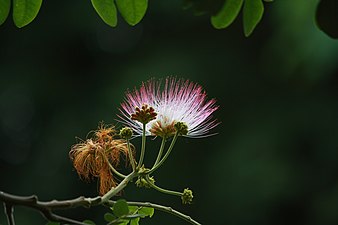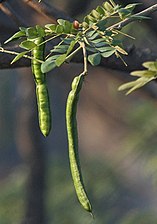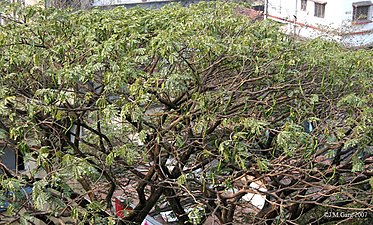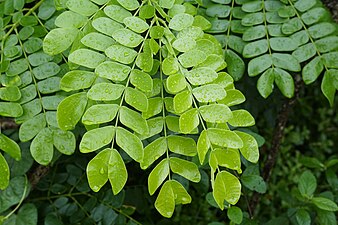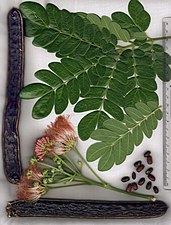Samanea saman
| Samanea saman | |
|---|---|
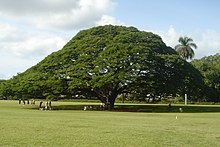
| |
| The Hitachi Tree at the Moanalua Gardens, Hawaii | |
| Scientific classification | |
| Kingdom: | Plantae |
| Clade: | Tracheophytes |
| Clade: | Angiosperms |
| Clade: | Eudicots |
| Clade: | Rosids |
| Order: | Fabales |
| Family: | Fabaceae |
| Subfamily: | Caesalpinioideae |
| Clade: | Mimosoid clade |
| Genus: | Samanea |
| Species: | S. saman
|
| Binomial name | |
| Samanea saman | |
| Synonyms[3] | |
|
List
| |

Samanea saman is a species of flowering tree in the pea family, Fabaceae, now in the Mimosoid clade[5] and is native to Central and South America.[6] It is often placed in the genus Samanea,[7] which by yet other authors is subsumed in Albizia entirely.
Its range extends from
In Cambodia it is colloquially known as the Chankiri Tree (can be written ចន្ទគិរី or ចន្ទ៍គីរី).
Description
Tree
Saman is a wide-canopied tree with a large symmetrical umbrella-shaped crown. It usually reaches a height of 15–25 m (49–82 ft) and a diameter of 30 m (98 ft).[6]
This species of flowering tree in the Fabaceae family is native to Central and South America but has been widely introduced across the tropics, especially South and Southeast Asia.[citation needed]
Its branches have velvety and hairy bark.[9] Large branches of the tree tend to break off, particularly during rainstorms. This can be hazardous as the tree is very commonly used for avenue plantation.[citation needed]
A rain tree leaf is pinnate made of 6–16 leaflets, each leaflet is shaped like a diamond 2–4 centimetres (0.79–1.57 in) long and 1–2 centimetres (0.39–0.79 in) wide with a dull top surface and finely hairy beneath. The tree sheds its leaves for a while during dry periods.[6] Its crown is big and can provide shade, but allows rain to fall through into the ground beneath it.[9]
The leaves fold in rainy weather and in the evenings, hence the names rain tree and five o'clock tree.[10]
Flowers and seeds
The tree has pinkish flowers with white and red stamens, set on heads with around 12–25 flowers per head. These heads may number in the thousands, covering the whole tree.[6]
The
-
Flower
-
A pollen grain
-
Pods
Names
In English it is usually known as rain tree or saman. It is also known as "monkey pod", "giant thibet", "inga saman",[note 1] "cow tamarind",[13] East Indian walnut,[note 2] "soar", or "suar". In English-speaking regions of the Caribbean, it is known as coco tamarind in Grenada; French tamarind in Guyana; and samaan tree in Trinidad.[13] In Philippine English, it is confusingly simply known as "acacia", due to its resemblance to native Acacia species.[14]

The original name, saman - known in many languages and used for the
The origin of the name "rain tree" is unknown. It has been variously attributed to local names ki hujan or pokok hujan ("rain tree") in
In the Caribbean, it is sometimes known as marsave. It is also known as algarrobo in Cuba; guannegoul(e) in Haiti; and goango or guango in Jamaica. In French-speaking islands, it is known as gouannegoul or saman.[citation needed]
In Latin America, it is variously known as samán, cenízaro, cenicero, genízaro, carreto, carreto negro, delmonte, dormilón, guannegoul, algarrobo del país, algarrobo, campano, carabeli, couji, lara, urero, or zarza in Spanish; and chorona in Portuguese.[14]
In the
In Southeast Asia, it is known as akasya or palo de China in the Philippines;[14] meh or trembesi in Indonesia; pukul lima ("five o'clock tree") in Malaysia and Singapore;[17][18] ampil barang ("Western tamarind") in Cambodia;[19] ก้ามปู (kampu), ฉำฉา (chamcha), จามจุรีแดง (chamchuri daeng), จามจุรี (chamchuri) in Thai; ကုက္ကို (kokko) in Myanmar; and còng, muồng tím, or cây mưa ("rain tree") in Vietnam.
In South Asia, it is known as shiriisha in Sanskrit; শিরীষ (shirish) in Bengali; shirish in Gujarati; सीरस (vilaiti siris) in Hindi; bagaya mara in Kannada; ചക്കരക്കായ് മരം (chakkarakkay maram) in Malayalam; विलायती शिरीश in Marathi; mara in Sinhalese; தூங்குமூஞ்சி மரம் (thoongu moonji maram, "sleepy faced tree") in Tamil; and నిద్ర గన్నేరు (nidra ganneru) in Telugu.[citation needed]
In Madagascar, it is also known as bonara (mbaza), kily vazaha, madiromany, mampihe, or mampohehy.[citation needed]
In European regions where the tree does not usually grow, its names are usually direct translations of "rain tree". These include arbre à (la) pluie (France), árbol de lluvia (Spain); and Regenbaum (Germany).[citation needed]
Use
The edible fruit pulp can be made into a beverage that tastes like lemons; the pulp is also an additive to gasoline.[9]
Its wood is used for carving and making furniture.[6]
The "Samanea saman" tree is one of several types of host plants that allows lac insects (Kerria lacca) infestation. The resultant copious sap/insect discharge caused by this insect is a harden material that is subsequently collected and processed into lac/shellac and used in making lacquerware and wood finishes.
Raintrees around the world
In Cambodia
It is unclear when and how Chankiri was introduced to Cambodia. It is possible the tree was introduced from Brazil by the French in the 1920s, together with the rubber tree (Hevea brasiliensis) during the rubber industry's global boom in the early 1900s. It is also possible the tree came from neighboring countries in the region where the plant had been introduced earlier on by Western colonial explorers.[citation needed]
Since its introduction to Cambodia, the Samanea saman is known locally as chankiri (ចន្ទគិរី). It has been widely planted across the country thanks to its tall height and expansive branches that can shade large areas, and as an ornamental. The fruit is eaten, and in famine times the young leaves are eaten in salads.[19]
Chamri (ចាមរី)[20] is the official Khmer name for the plant because the flowers from this tree resemble the beautiful long-haired tail of the chamri (known in English as yak). Ampil barang (French tamarind) is another colloquial name for it in Cambodia.
Chankiri Trees in the Killing Fields
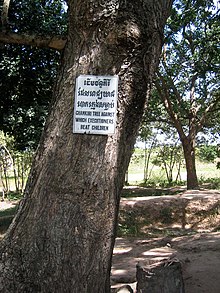
Since its introduction to Cambodia, Chankiri has been widely planted across the country thanks to its tall height and expansive branches that can shade large areas. Multiple chankiri can also be found in the
It was a coincidence that the Chankiri tree at the Killing Fields is one of the many trees against which the Khmer Rouge executioners beat young children and there are no specific associations locally between the Chankiri tree and the Khmer Rouge.[citation needed]
In Venezuela
When
The tree, called Samán de Güere (

Carbon sequestration
Gallery
-
Si Phan Don, Laos
-
Falling leaves in Kolkata, West Bengal
-
Sukabumi, West Java
-
Detail of the leaves
-
Leaves, flowers, dried pods, seeds
-
Mature bark
-
Black-rumped flameback (Dinopium benghalense)
Notes
Footnotes
- ^ Botanic Gardens Conservation International (BGCI) & IUCN SSC Global Tree Specialist Group. 2019. Samanea saman. The IUCN Red List of Threatened Species 2019: e.T144255307A148988354. https://dx.doi.org/10.2305/IUCN.UK.2019-2.RLTS.T144255307A148988354.en. Accessed on 01 March 2024.
- ^ "Albizia saman. NatureServe Explorer 2.0". explorer.natureserve.org. Retrieved 1 March 2024.
- ^ a b "Samanea saman (Jacq.) Merr". Plants of the World Online. Royal Botanic Gardens, Kew. Retrieved 3 March 2020.
- ^ Merrill, E.D. (1916). Journal of the Washington Academy of Sciences. 6: 47.
{{cite journal}}: Missing or empty|title=(help) - hdl:10568/90658.
- ^ ISBN 978-0-9702544-5-0.
- ^ "Samanea saman". Germplasm Resources Information Network. Agricultural Research Service, United States Department of Agriculture. Retrieved 2010-03-25.
- ^ a b c von Humboldt & Bonpland (1820): p.99 footnote
- ^ a b c Arditti, Joseph; Mak Chin On (1999). "The Golden Rain Tree". Maryland Nursery. Archived from the original on 15 Jun 2013.
- ^ "Samanea saman (Jacq.) Merr". National Parks, A Singapore Government Official Website.
- ^ ISBN 978-0-299-08400-4.
- S2CID 253665652.
- ^ legumes, it is not very closely related to tamarinds.
- ^ a b c d Staples, George W.; Elevitch, Craig R. (2006). Samanea saman (rain tree). Species Profiles for Pacific Island Agroforestry.
- ^ Ahmad Azaruddin MN (4 June 2013). "Samanea saman: The umbrella-like rain tree". Colours of FRIM. Forest Research Institute Malaysia. Retrieved 1 March 2023.
- ^ Keppel, Gunnar; Ghazanfar, Shahina A. (2011). Trees of Fiji: A Guide to 100 Rainforest Trees (third, revised ed.). Secretariat of the Pacific Community & Deutsche Gesellschaft für Technische Zusammenarbeit. pp. 204–5.
- ISBN 983-2181-51-8.
- ^ "Rain Tree". Gardens, Parks & Nature. National Parks Board. 24 June 2021. Retrieved 2 March 2023.
- ^ a b Pauline Dy Phon (2000). Plants Utilised In Cambodia/Plantes utilisées au Cambodge. Phnom Penh: Imprimerie Olympic. p. 174.
- ^ Dictionnaire Cambodgien, Fifth Edition. Edition De L’Institut Bouddhique. 1967.
- ISBN 978-1-60623-037-4.
- ^ von Humboldt & Bonpland (1820): pp.98-100
- ^ <not stated> (November 4, 2012). "Landmark Trees of India".
- ^ "Save the earth by planting Trembesi".
References
- Arditti, Joseph & On, Mak Chin (2004): The Golden Rain Tree. Version of 2004-MAY-01. Retrieved 2008-MAR-31.
- International Legume Database & Information Service (ILDIS) (2005): Albizia saman. Version 10.01, November 2005. Retrieved 2008-MAR-30.
- von Humboldt, Alexander & Bonpland, Aimé (1815): Reise in die Aequinoctial-Gegenden des neuen Continents (Part 3). J.G. Cotta, Stuttgart and Tübingen. Image/PDF fulltext at Google Books
External links
 Media related to Albizia saman at Wikimedia Commons
Media related to Albizia saman at Wikimedia Commons Data related to Samanea saman at Wikispecies
Data related to Samanea saman at Wikispecies- Hawaiian Ecosystems at Risk Project page for Samanea saman
- Reference for Telugu word Nidra Ganneru



